These higher-channel-count systems in an infotainment system may integrate:
这些信息娱乐系统中的高通道数系统可能集成:
A center speaker.
中置音箱。Separate tweeter/midrange/woofer speakers.
独立高频音箱/中音音箱/低音音箱。Instrument cluster chimes or warning tones.
仪表盘警报声或提示音。Additional speakers to communicate information, such as warning drivers to take control of steering or braking if the vehicle is operating in a semi-autonomous driving mode.
其他可以传递信息的音箱,如警告驾驶员在车辆处于半自动驾驶模式时控制方向盘或刹车。Some higher-end car models may actually have as many as 20 speakers. The speakers in these audio systems are driven by an external amplifier typically placed near the trunk of the car. These audio systems also incorporate more advanced sound algorithms such as active noise cancellation to deliver a more personalized audio experience.
一些高端汽车模型实际上可能有多达20个音箱。这些音频系统中的音箱由通常安装在汽车后备箱附近的外部放大器驱动。这些音频系统还包括更先进的声音算法,如可以提供更加个性化音响体验的主动降噪技术。
With each subsequent model year, automakers are adding more and more electronics. Coupled with the need to drive six to eight speakers directly from the infotainment system, space behind the dashboard is now at an all-time premium. Therefore, it’s becoming a priority for audio hardware designers to develop smaller automotive audio amplifier solutions with lower heat dissipation. In this paper, I’ll describe four factors that drive overall audio amplifier size:
在随后的每一个车型年,汽车制造商正在增加越来越多的电子器件。再加上需要直接从信息娱乐系统驱动6到8个音箱,仪表盘后面的空间现在是前所未有的出色。因此,音频硬件的设计师应首先开发散热更低的小型汽车音频放大器解决方案。在本文中,我将描述驱动整体音频放大器的四个因素:
Efficiency/thermal performance.
效率/热性能。Switching frequency.
开关频率。Inductor size.
电感器尺寸。Package design.
包装设计。Efficiency/thermal performance
效率/热性能
Designers have traditionally designed car radios using Class- AB linear audio amplifiers. Class-AB linear amplification is drastically less efficient than the newer but well-established Class-D switching technology. Figure 1 highlights the difference.
传统上,设计人员使用AB类线性音频放大器来设计汽车收音机。AB类线性放大技术远没有新的、但相当成熟的D类交换技术高效。图1突出了其差别。
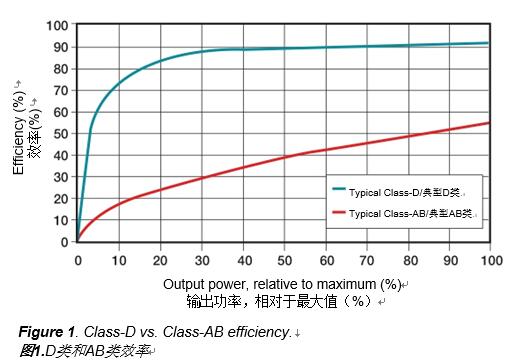
Class-AB efficiency loss leads directly to additional internal heat generation, which then requires dissipation outside the audio amplifier. The need for a larger heat sink in Class-AB designs also exacerbates the challenge to continuously reduce the overall automotive audio amplifier system solution size.
AB类效率损失直接导致内部产生额外热量,然后需要在音频放大器外部进行散热。由于AB类设计需要更大的散热器,这也使持续减小整个汽车音频放大器系统解决方案尺寸变得更加困难。
Class-D amplifiers can achieve the same output power but dissipate significantly less heat, enabling designers to use a much smaller and less complex heat sink to transport dissipated power to the ambient environment.
D类放大器能够获得相同的输出功率,但散热显著减少,这使得设计人员能够使用更小、更简单的散热器将散热量传输到周围环境中。
Switching frequency
开关频率
The number of electronics mounted behind the dashboard in a relatively tight space increases the possibility that circuits can emit interfering signals in close proximity. Ultimately, modern radios and audio amplifiers must provide better immunity from electromagnetic interference (EMI) in the AM band to meet these challenges.
安装在仪表盘后面相对狭小空间内的电子器件数量增加了电路可以近距离发射干扰信号的可能性。更重要的是,现代收音机和音频放大器必须在AM波段中提供更好的抗电磁干扰性能(EMI),以应对这些挑战。
In the U.S., AM radio stations broadcast in the 535-kHz to 1705-kHz frequency band. Existing Class-D audio amplifier designs typically operate with a fundamental switching frequency in the 400-kHz to 500-kHz range. These lowers-witching- frequency Class-D amplifier designs create harmonics that occur directly within the AM band, as shown in Figure 2.
美国AM广播电台的波段范围为535-kHz至1705-kHz。现有的D类音频放大器设计通常在400 kHz至500 kHz范围内以基本开关频率运行。这些低开关频率D类放大器设计直接在AM波段内产生谐波,如图2所示。
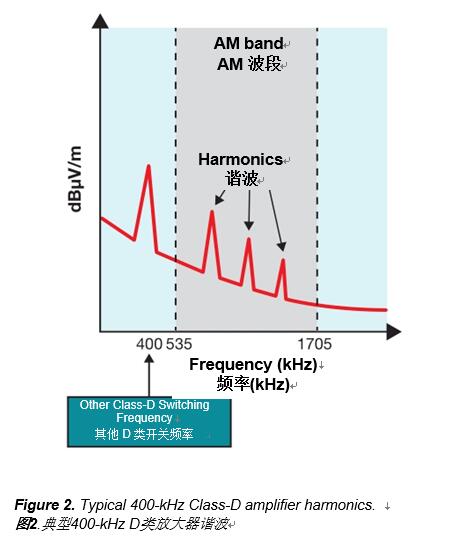
The harmonics create interfering signals that reduce the sensitivity of the AM receiver, thereby hindering AM radio station reception. Implementing an AM avoidance scheme on Class-D amplifier designs mitigates the effects of these harmonics.
谐波会产生降低AM接收器灵敏度的干扰信号,从而妨碍AM广播电台接收。在D类放大器设计上运用AM避免技术能够减轻这些谐波的影响。
Class-D audio amplifiers require reconstruction filters to convert the pulse-width modulation (PWM) signal from the amplifier output into the desired analog audio signal. These output filters are made with inductors (L) and capacitors (C) (as shown in Figure 3) for a typical bridge-tied load (BTL) amplifier circuit, and help minimize EMI from the highspeed switching transients on the output stages of Class-D amplifiers.
D类音频放大器需要重建滤波器将放大器输出的脉冲宽度调制(PWM)信号转换为所需的模拟音频信号。这些输出滤波器由电感器(L)和电容器(C)构成(如图3所示),用于典型的桥接负载(BTL)放大器电路,且能够更大限度地减少D类放大器输出级上的高速开关瞬态电磁干扰。
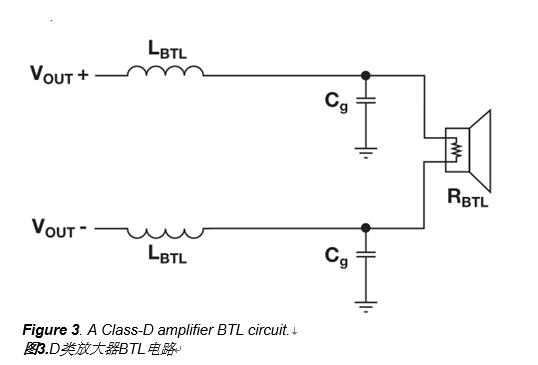
Automotive Class-D audio amplifiers that operate at a 2.1-MHz switching frequency provide significant margin above the AM band, as shown in Figure 4. This design is free of any lower-frequency spikes that would interfere with the AM band, thus eliminating the need for an AM avoidance scheme.
在2.1-MHz开关频率下运行的汽车D类音频放大器在AM波段上方提供显著裕度,如图4所示。此设计不存在任何会干扰AM波段的低频尖峰,因而不再需要AM避免技术。
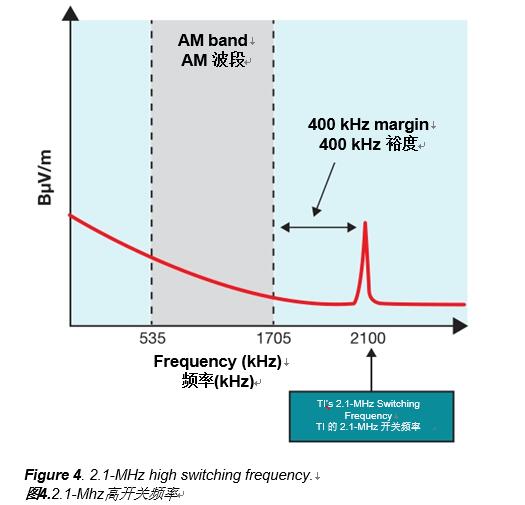
As an additional benefit, a 2.1-MHz switching frequency enables a lower inductance value for the output filter due to the inherent reduction in ripple current. A lower inductance for an equivalent current rating leads to a smaller inductor, reducing printed circuit board (PCB) area and subsequently the EMI footprint.
另一个好处是,由于纹波电流的内在减少,2.1-MHz开关频率可以使输出滤波器的电感值更低。等效额定电流的低电感会导致电感较小,从而减少印刷电路板(PCB)面积,且随后减少EMI占用面积。
Inductor size
电感器尺寸
For Class-D automotive audio amplifiers, the value of the inductor required in the LC filter to ensure the proper PWM demodulation filter characteristic depends on the switching frequency. As shown in Figure 5, a 400-kHz automotive audio amplifier typically uses either a 10-μH or 8.2-μH inductor value, while a 2.1-MHz higher-switching-frequency amplifier design can take advantage of a much smaller and lighter-weight inductor in the range of 3.3 μH to 3.6 μH (assuming that each amplifier provides the same output power).
对于D类汽车音频放大器,LC滤波器所需的电感值(用以确保合适PWM解调滤波器特性)取决于开关频率。如图5所示,400-kHz汽车音频放大器通常使用10-μH或8.2-μH电感值,而2.1-MHz高开关频率放大器设计可以利用3.3μH至3.6μH范围内更小更轻的电感器(假设每个放大器提供相同的输出功率)。
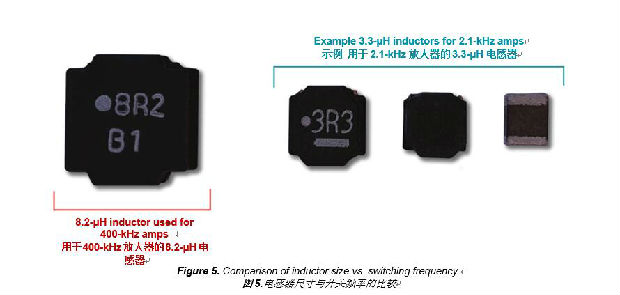
As I mentioned earlier, a typical car radio design has at least four channels to drive two front speakers and two rear speakers. This simple configuration requires eight inductors for a Class-D automotive audio amplifier, since each channel requires two inductors, as shown earlier in Figure 3. Thus, the size of each inductor is multiplied by 8, which is a significant contribution to overall PCB size and design weight. As a general reference, the transition from 8.2-μH inductors to 3.3-μH inductors can save over 85% in inductor space on the PCB and over 85% in weight.
正如之前提到的,典型汽车收音机设计至少有4个通道来驱动2个前端扬声器和2个后端扬声器。这种简单的配置需要8个电感器以用于D类汽车音频放大器,因为每个通道需要2个电感器,如图3所示。因此,每个电感器的尺寸乘以8,对整体PCB尺寸和设计重量有着重要的影响。一般来说,从8.2-μH电感器转换到3.3-μH电感器可以节省电路板上85%以上的电感器空间和减小85%以上的重量。
Package design
包装设计
Another audio amplifier consideration that can greatly contribute to the overall system solution size of an automobile’s infotainment system is the design of the amplifier package.
另一个能够大大减小汽车信息娱乐系统中整体系统解决方案尺寸的音频放大器注意事项是放大器包装的设计。
A square-shaped package design has inputs on the bottom of the package and two audio outputs with LC filters orthogonally placed on either side of the amplifier. As you can see in Figure 6, this type of package design greatly contributes to the overall PCB footprint.
正方形包装设计在包装底部有输入,还有两个音频输出,且LC滤波器正交放置在放大器的一侧。如图6所示,这种类型的包装设计大大增加了整个PCB的占用面积。
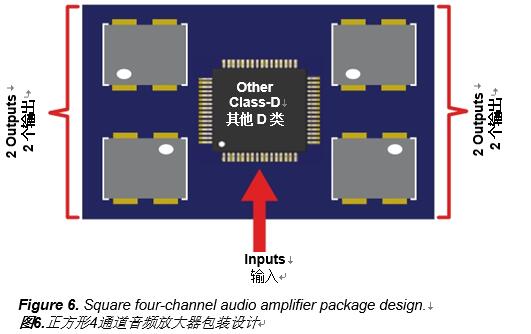
A better option is a rectangular package that has a “flowthrough” audio signal design. Figure 7 illustrates how the analog input signals come into the amplifier on one side of the chip; amplification of the audio signal takes place on the opposite side of the amplifier, where the signals are then delivered into external output filters.
带有“流式”音频信号设计的正方形包装是更好的选择。图7说明了模拟输入信号如何进入芯片一侧的放大器;音频信号的放大发生在放大器的另一侧,信号随后被传送到外部输出滤波器中。
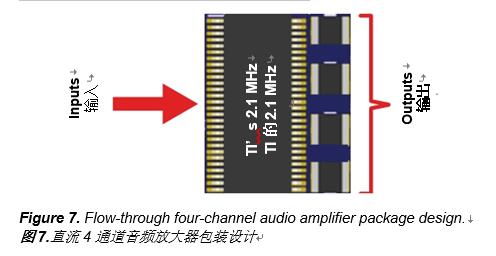
The TPA6304-Q1 audio amplifier uses a 2.1-MHz highswitching- frequency Class-D amplifier technology that features TI Burr-Brown8482; technology. By combining 3.3-μH metal alloy inductors and a flow-through package design, the TPA6304-Q1 delivers a four-channel automotive Class-D amplifier solution size that measures only 17 mm by 16 mm. See Figure 8.
TPA6304-Q1音频放大器使用具有TI Burr-Brown™技术的2.1-MHz高开关频率D类放大器技术。TPA6304-Q1通过结合3.3-μH金属合金电感器和直流包装设计,可以提供一个尺寸只有17 mm x 16 mm的4通道汽车D类放大器解决方案。见图8。
The TPA6304-

Q1, including all of the passive electronic components for the full system solution implementation, is even smaller than the traditional Class-AB amplifier by itself, as shown in Figure 9.
TPA6304-Q1(包括用于整体系统解决方案的所有无源电子元件)比传统的AB类放大器还要小,如图9所示。
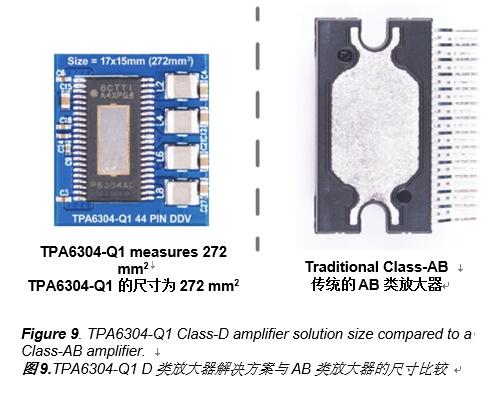
Conclusion
结论
The more electronics added to a car, the more the overall heat signature increases in an already tightly confined space behind the dashboard. Thus, the challenge for automotive audio hardware designers is to implement smaller and smaller audio solutions with lower and lower heat dissipation. Audio amplifier efficiency will only become more important in the future of infotainment system design.
汽车上安装的电子器件越多,仪表盘后狭小空间内的整体热量就越来越高。因此,汽车音频硬件设计人员面临的挑战是实现更小、散热更低的音频解决方案。音频放大器的效率只会在未来的信息娱乐系统设计中变得更加重要。
The TPA6304-Q1 makes replacing a Class-AB automotive audio amplifier easy. Its 2.1-MHz switching frequency and tiny system solution size allow you to achieve Class-D efficiency at a Class-AB system cost.
TPA6304-Q1可轻易取代AB类汽车音频放大器。TPA6304-Q1的2.1-MHz开关频率和小型系统解决方案尺寸可以让你以AB类系统成本实现D类效率。